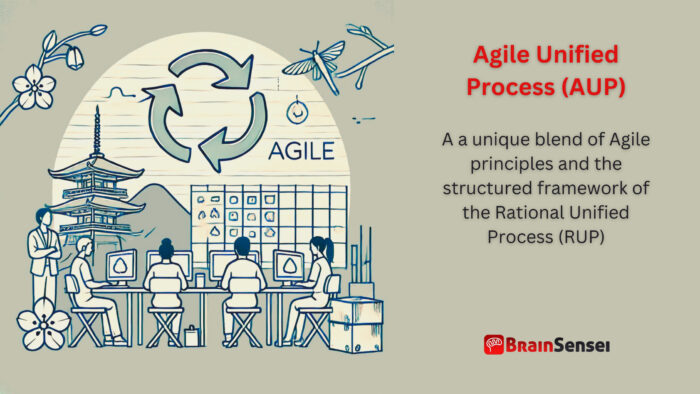
Agile Unified Process (AUP)
What is an Agile Unified Process (AUP)?
Agile Unified Process (AUP) is a unique blend of Agile principles and the structured framework of the Rational Unified Process (RUP). This innovative approach results in an iterative, incremental, lightweight, and disciplined software development methodology. It ensures flexibility, adaptability, and efficiency in project execution.
Key Takeaways
- AUP is a simplified version of the Rational Unified Process (RUP) with Agile principles
- It follows an iterative and incremental development approach
- Encourages adaptability, collaboration, and continuous feedback
- Focuses on delivering high-quality software efficiently
- Suitable for teams that need a structured Agile approach without excessive complexity
Understanding Agile Unified Process (AUP)
How It Works
AUP incorporates Agile methodologies into RUP’s structured approach, resulting in a lightweight framework for software development. It consists of four major phases:
- Inception: Establishes project scope, objectives, and feasibility.
- Elaboration: Refines project architecture, requirements, and risk management.
- Construction: Implements the system through iterative development cycles.
- Transition: Deploy the final product to users and stakeholders.
AUP simplifies RUP by emphasizing Agile values such as:
- Iterative development with frequent releases.
- Customer collaboration and feedback integration.
- Continuous testing and adaptability.
Important Considerations
- AUP is ideal for teams that find traditional RUP too rigid but need more structure than pure Agile methods.
- It retains core RUP disciplines like requirements, modelling, and configuration management.
- Documentation is lightweight and focuses on essential artifacts.
- Unlike traditional RUP, AUP reduces ceremony and emphasizes working software. This focus on efficiency ensures that the team’s efforts are always directed towards productive tasks, making them feel more accomplished and productive.
- It integrates well with DevOps and modern software delivery pipelines.
Related Terms
- Rational Unified Process (RUP): A structured software development framework emphasizing phases and disciplined engineering practices.
- Scrum: An Agile framework focused on iterative development with defined roles, events, and artifacts.
- Kanban: A visual workflow management method that enables continuous delivery.
- Extreme Programming (XP): An Agile methodology emphasizing technical excellence and frequent releases.
- Lean Software Development: A methodology derived from Lean Manufacturing that focuses on reducing waste and increasing efficiency
- Scaled Agile Framework (SAFe): A framework for implementing Agile at an enterprise scale.
Examples of Agile Unified Process (AUP) in Different Industries
AUP in the Manufacturing Industry
A leading manufacturing company implemented a real-time inventory tracking system to improve supply chain efficiency and reduce warehouse errors.
During the Inception phase, the company established project goals, including reducing stock discrepancies, minimizing lead times, and improving vendor collaboration.
In the Elaboration phase, the team defines the system architecture and addresses risk factors such as integration with existing ERP systems. The team also identifies key performance indicators (KPIs) to measure success.
In the Construction phase, they carry out the development in iterative cycles. The software team focused on implementing barcode scanning, automated stock updates, and AI-driven demand forecasting. Each sprint introduced incremental improvements based on user feedback.
During the Transition phase, they deployed the system in phases across multiple warehouses. The team conducted training sessions to ensure smooth adoption, and feedback loops helped refine the software. After deployment, the company reported a 40% reduction in stock discrepancies and a 25% improvement in inventory turnover.
AUP in Healthcare & Pharmaceuticals
A global pharmaceutical company needed an advanced clinical trial data management system to comply with regulatory requirements while enhancing trial efficiency.
The Inception phase involved identifying project objectives such as ensuring patient data security, streamlining reporting, and meeting FDA compliance.
During the Elaboration phase, the team refines the workflows and addresses potential risks, such as data breaches and regulatory non-compliance. The team also outlines the necessary integrations with existing hospital record systems.
In the Construction phase, Agile iterations focused on building a secure database, implementing AI-driven analytics for faster trial results, and developing a real-time dashboard for researchers.
The Transition phase involved rolling out the system across multiple clinical sites. User training ensured proper utilization, and continuous feedback allowed for ongoing optimization. As a result, the company reduced data processing times by 50% and improved compliance adherence, accelerating the drug approval process.
AUP in Telecommunications
A primary telecom provider sought to enhance its customer service platform by integrating AI-driven support solutions.
In the Inception phase, the company identified challenges such as high call center wait times and customer dissatisfaction.
The Elaboration phase focused on defining technical requirements, assessing integration needs, and setting project milestones. Risk management strategies included ensuring AI bias mitigation and data security compliance.
During Construction, iterative sprints led to the gradual deployment of AI-powered chatbots, intelligent ticketing systems, and predictive analytics tools. These enhancements reduced response times and automated repetitive tasks, improving overall efficiency.
The Transition phase involved full-scale deployment, user testing, and continuous refinement based on customer feedback. As a result, the telecom provider reduced service resolution time by 30% and increased customer satisfaction ratings by 20%.
These examples showcase AUP’s ability to deliver structured yet flexible solutions tailored to industry-specific needs.
Use Cases of Agile Unified Process (AUP)
United States (FinTech Startup)
A US-based FinTech startup is developing an innovative mobile banking application. Following the AUP, the team begins with the Inception phase, defining goals such as secure transactions, user-friendly interfaces, and compliance with financial regulations.
During the Elaboration phase, the team finalizes the technical architecture and conducts risk assessments to address cybersecurity concerns. The team iterates on security protocols, fraud detection mechanisms, and seamless API integrations with third-party financial services.
Agile sprints lead to incremental feature releases in the Construction phase, ensuring the integration of customer feedback at each stage. Testing cycles improve user authentication, while beta testing helps refine user experience.
The Transition phase includes deploying the application in phases, monitoring performance, and gathering continuous feedback for future iterations. After six months, the startup successfully launches the app, attracting over 500,000 users in the first year and maintaining a high-security compliance standard.
Europe (Automotive Industry)
A European automotive manufacturer implements AUP to develop advanced software for autonomous vehicle testing. The Inception phase focuses on regulatory compliance, AI-powered navigation algorithms, and safety considerations.
During Elaboration, the engineering team evaluates real-time data processing needs, integration with sensor technologies, and risk mitigation for edge-case scenarios. The team establishes key performance metrics to ensure system reliability in diverse driving conditions.
In the Construction phase, iterative development leads to continuous enhancements in machine learning models, lane detection systems, and real-time hazard identification. Developers refine software using test vehicles in controlled environments, adjusting algorithms to improve decision-making accuracy.
The Transition phase involves large-scale testing on public roads and collecting extensive feedback from real-world driving conditions. After regulatory approval, the company successfully integrates its software into next-generation autonomous vehicle prototypes, reducing error rates by 40%.
Asia (E-commerce Expansion)
An Asian e-commerce company uses AUP to scale its cross-border payment platform. In the Inception phase, the company defines key objectives such as multi-currency support, fraud prevention, and compliance with international banking regulations.
During the Elaboration phase, engineers identify system architecture needs, ensuring the platform can handle high transaction volumes while providing secure payment authentication. They also develop strategies to address compliance variations across different markets.
The Construction phase involves gradually implementing payment processing gateways, integrating with regional financial institutions, and developing adaptive fraud detection algorithms. Each iteration improves transaction speeds and reduces chargeback rates.
Finally, in the Transition phase, the company rolls out the platform to new regions, monitoring transaction success rates and customer feedback. The AUP approach ensures adaptability, allowing the company to confidently expand into new markets and ultimately increase its revenue by 60% within a year.
These examples demonstrate how AUP facilitates structured yet flexible software development. It allows organizations to balance discipline with iterative improvements for optimal results.
Best Practices for Implementing Agile Unified Process (AUP)
Successfully implementing AUP requires a balance between Agile flexibility and structured discipline. The following best practices help organizations maximize the benefits of AUP while avoiding common pitfalls.
Balance Agility with Necessary Structure
AUP aims to simplify RUP while incorporating Agile principles, but organizations must strike the right balance. Too much structure can create unnecessary bureaucracy, while too little can lead to confusion and misalignment. Establish straightforward but flexible workflows that allow for adaptability without sacrificing order.
Prioritize Working Software Over Documentation
One of the primary advantages of AUP is its lightweight documentation approach. While some documentation is necessary to maintain project clarity, teams should prioritize working software over extensive paperwork. Only document what is essential and relevant to project goals.
Foster Continuous Collaboration
Successful AUP implementation relies on strong collaboration among developers, stakeholders, and end-users. Regular communication ensures alignment with business goals and helps teams respond to changing requirements. To maintain engagement, utilize daily stand-up meetings, sprint reviews, and retrospectives.
Regularly Assess and Refine Risks
Risk management is an integral part of AUP. During the Elaboration phase, teams should identify potential risks and develop mitigation strategies. However, risk management should not be a one-time activity—teams must continuously assess and refine risk plans throughout the Construction and Transition phases.
Embrace Iterative Development
AUP’s iterative approach enables teams to develop, test, and refine software in small increments. Breaking down development into manageable iterations helps detect issues early, reduces rework, and allows continuous improvements. Ensure that each iteration delivers value to stakeholders.
Integrate Emerging Technologies and Methodologies
Technology evolves rapidly, and teams using AUP should remain adaptable to incorporate new tools, frameworks, and best practices. Integrating DevOps methodologies, automated testing, and cloud-based solutions can improve efficiency and scalability.
Encourage a Culture of Feedback
AUP promotes continuous feedback loops to enhance software quality and stakeholder satisfaction. Teams should actively seek user feedback and incorporate it into development cycles. Feedback-driven improvements lead to better alignment with business needs and user expectations.
Ensure Cross-Functional Team Collaboration
AUP teams should have cross-functional members with diverse skill sets, including developers, testers, business analysts, and UX designers. This interdisciplinary approach addresses all aspects of the software development lifecycle within Agile iterations.
Maintain a Customer-Centric Approach
AUP integrates Agile principles that prioritize customer needs. Teams should focus on delivering high-value features and solutions that meet user expectations. Frequent releases and user testing help validate requirements and refine product functionality.
Optimize Resource Allocation
Efficient resource management ensures that AUP projects run smoothly. Teams should track workload distribution and identify bottlenecks early. Optimizing resource allocation allows for efficient sprint execution and prevents burnout among team members.
Align with Business Objectives
While AUP is primarily a technical framework, it should align with broader business goals. Development teams should regularly engage with business stakeholders to ensure software functionality supports organizational objectives.
Measure Performance and Adapt
Teams should establish key performance indicators (KPIs) to measure the effectiveness of AUP implementation. Metrics such as sprint velocity, defect rates, and customer satisfaction scores provide insights into areas for improvement. Adaptability is crucial—if a process isn’t working, teams should refine it to enhance productivity.
Challenges of Poor AUP Implementation
Failure to follow best practices can lead to inefficiencies, miscommunication, and project failures. Common challenges include:
- Overengineering: Adding unnecessary complexity to workflows.
- Lack of Stakeholder Involvement: Misalignment with business needs.
- Inadequate Risk Management: Ignoring potential obstacles.
- Resistance to Change: Difficulty adapting to Agile principles.
- Insufficient Testing: Deploying software with undetected defects.
Adhering to AUP best practices can help organizations create a structured yet adaptable software development process that delivers high-quality results.
Agile Unified Process (AUP): Common Mistakes and Issues
While AUP offers a balanced approach between Agile and structured software development, inevitable mistakes and issues can hinder its effectiveness. Here are some of the most common challenges teams face when implementing AUP and how to mitigate them.
Overcomplicating AUP Implementation
A key benefit of AUP is its lightweight nature, yet many organizations unintentionally add unnecessary complexity. Excessive documentation, rigid workflows, and redundant approval processes can slow development and negate Agile adaptability’s benefits.
Solution: Minimize documentation, focusing only on essential artifacts. Ensure processes remain streamlined and teams have workflow flexibility while adhering to core AUP principles.
Lack of Stakeholder Involvement
Stakeholder engagement is crucial in AUP, as frequent feedback drives iterative improvements. If business leaders, end-users, or product owners are not actively involved, the software may not align with organizational goals or user needs.
Solution: Foster a culture of continuous collaboration by involving stakeholders in key discussions, sprint reviews, and backlog prioritization meetings. Gather feedback regularly and incorporate it into the development cycle.
Inadequate Risk Management
While the AUP includes risk assessment during the Elaboration phase, failing to reassess risks throughout development continuously can lead to unforeseen obstacles. The project team must proactively manage issues such as integration challenges, security vulnerabilities, or changing business needs; otherwise, they can derail projects.
Solution: Implement a continuous risk evaluation process. Revisit risk assessments at the end of each iteration to address new potential risks before proceeding.
Poorly Defined Roles and Responsibilities
AUP requires clear roles and responsibilities among team members. In some cases, teams struggle with accountability, leading to miscommunication and inefficiencies in project execution.
Solution: Clearly define roles at the beginning of the project and ensure that all team members understand their responsibilities. Encourage cross-functional collaboration and establish clear communication channels.
Resistance to Change
Transitioning from traditional methodologies such as Waterfall or full RUP to AUP can be challenging for teams unfamiliar with Agile principles. Resistance to change may lead to partial adoption, where teams continue following old habits, reducing the effectiveness of AUP.
Solution: Provide Agile training and workshops for teams and leadership to help them understand the benefits of AUP and encourage a mindset shift toward continuous iteration and collaboration.
Insufficient Automated Testing
One of the fundamental Agile principles is frequently delivering working software, but some AUP implementations lack robust automated testing frameworks. This deficiency can lead to defects accumulating over time, requiring costly rework later in the project.
Solution: Integrate automated testing into the development cycle. Continuous integration (CI) and continuous deployment (CD) pipelines can help detect and fix issues early, improving software quality and deployment speed.
Ignoring Feedback Loops
AUP relies on iterative feedback loops to refine and improve the software. Ignoring feedback from users, testers, and business stakeholders can lead to misaligned product features and wasted development efforts.
Solution: Actively collect and analyze feedback after each iteration. Implement user testing, surveys, and retrospectives to identify improvement areas and promptly incorporate necessary changes.
Over-Reliance on Agile Without Structure
While Agile promotes flexibility, a complete lack of structure can lead to chaos in development. Without clear milestones and documented progress, teams may struggle with scope creep and misalignment with business goals.
Solution: Balance Agile adaptability with necessary structure. Use AUP’s defined phases (Inception, Elaboration, Construction, and Transition) as checkpoints to ensure that project objectives remain clear while maintaining flexibility in execution.
Mismanagement of Technical Debt
As teams iterate quickly, they may accumulate technical debt by taking shortcuts in coding, documentation, or architecture. If left unchecked, technical debt can slow down future development and introduce long-term maintenance challenges.
Solution: Allocate time within each sprint to address technical debt. Refactor code regularly, update documentation and optimize system architecture to maintain a sustainable development pace.
Failing to Measure Success
Without clear success metrics, evaluating the effectiveness of an effective strategy is difficult. Teamsam members may deliver software on time, but long-term success remains uncertain without measuring factors like user adoption, defect rates, or stakeholder satisfaction.
Solution: Define key performance indicators (KPIs) at the start of the project. Track metrics such as sprint velocity, defect rates, user satisfaction scores, and deployment frequency to gauge project health and identify areas for improvement.
Agile Unified Process (AUP): Frequently Asked Questions (FAQs)
How does AUP differ from RUP?
AUP is a streamlined version of RUP that integrates Agile principles. It reduces process overhead while maintaining a structured approach.
Is AUP suitable for small teams?
Small teams can adapt AUP by focusing on essential workflows and minimizing documentation requirements.
How does AUP compare to Scrum?
AUP provides more structure than Scrum but less rigidity than traditional RUP, making it a hybrid approach suitable for various project sizes.
Can AUP be used with DevOps?
AUP aligns well with DevOps practices, supporting continuous integration and deployment.
What industries benefit most from AUP?
AUP significantly benefits industries requiring structure and agility, such as finance, healthcare, automotive, and telecommunications.
Additional Resources
- Agile Unified Process (AUP)
- Top 11 Agile Methodologies: Pros, Cons, and Use Cases
- Agile Development Models
- Rational Unified Process (RUP) Overview
- Agile Software Development
Preparing for a PMI certification?
- Exam Prep Courses: PMP®, CAPM®, and PMI-ACP®
- Exam Simulators: PMP®, CAPM®, PMI-ACP®, PMI-PBA®, PMI-RMP®, PMI-SP®, PgMP®, and PfMP®
- Professional Development Units (PDUs): 15, 30, and 60 PDU Bundles



